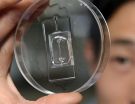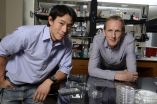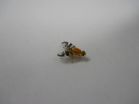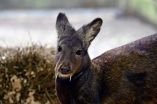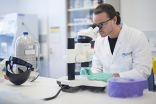(Press-News.org) Johns Hopkins engineers have invented a lab device to give cancer researchers an unprecedented microscopic look at metastasis, the complex way that tumor cells spread through the body, causing more than 90 percent of cancer-related deaths. By shedding light on precisely how tumor cells travel, the device could uncover new ways to keep cancer in check.
The inventors, from the university's Whiting School of Engineering and its Institute for NanoBioTechnology (INBT), published details and images from their new system recently in the journal Cancer Research. Their article reported on successful tests that captured video of human breast cancer cells as they burrowed through reconstituted body tissue material and made their way into an artificial blood vessel.
"There's still so much we don't know about exactly how tumor cells migrate through the body, partly because, even using our best imaging technology, we haven't been able to see precisely how these individual cells move into blood vessels," said Andrew D. Wong, a Department of Materials Science and Engineering doctoral student who was lead author of the journal article. "Our new tool gives us a clearer, close-up look at this process."
With this novel lab platform, Wong said, the researchers were able to record video of the movement of individual cancer cells as they crawled through a three-dimensional collagen matrix. This material resembles the human tissue that surrounds tumors when cancer cells break away and try to relocate elsewhere in the body. This process is called invasion.
Wong also collected video of single cancer cells prying and pushing their way through the wall of an artificial vessel lined with human endothelial cells, the same kind that line human blood vessels. By entering the bloodstream through this process, called intravasion, cancer cells are able to hitch a ride to other parts of the body and begin to form deadly new tumors.
To view these important early stages of metastasis, Wong replicated these processes in a small transparent chip that incorporates the artificial blood vessel and the surrounding tissue material. A nutrient-rich solution flows through the artificial vessel, mimicking the properties of blood. The breast cancer cells, inserted individually and in clusters in the tissue near the vessel, are labeled with fluorescent tags, enabling their behavior to be seen, tracked and recorded via a microscopic viewing system.
Wong's doctoral advisor, Peter Searson, the Joseph R. and Lynn C. Reynolds Professor of Materials Science and Engineering and director of the INBT, said his graduate student took on this challenging project nearly five years ago—and ultimately produced impressive results.
"Andrew was able to build a functional artificial blood vessel and a microenvironment that lets us capture the details of the metastatic process," said Searson, who was the corresponding author of the Cancer Research article and is a member of the Johns Hopkins Kimmel Cancer Center. "In the past, it's been virtually impossible to see the steps involved in this process with this level of clarity. We've taken a significant leap forward."
This improved view should give cancer researchers a much clearer look at the complex physical and biochemical interplay that takes place when cells leave a tumor, move through the surrounding tissue and approach a blood vessel. For example, the new lab device enabled the inventors to see detailed images of a cancer cell as it found a weak spot in the vessel wall, exerted pressure on it and squeezed through far enough so that the force of the passing current swept it into the circulating fluid.
"Cancer cells would have a tough time leaving the original tumor site if it weren't for their ability to enter our bloodstream and gain access to distant sites," Wong said. "So it's actually the entry of cancer cells into the bloodstream that allows the cancer to spread very quickly."
Knowing more about this process could unearth a key to thwarting metastasis.
"This device allows us to look at the major steps of metastasis as well as to test different treatment strategies at a relatively fast pace," Wong said. "If we can find a way to stop one of these steps in the metastatic cascade, we may be able to find a new strategy to slow down or even stop the spread of cancer."
Next, the researchers plan to use the device to try out various cancer-fighting drugs within this device to get a better look at how the medications perform and how they might be improved.
The new lab device to study metastasis is protected by a provisional patent obtained through the Johns Hopkins Technology Transfer office.
INFORMATION:
A video, images and an online audio interview related to this project are posted here:
http://inbt.jhu.edu/2014/10/17/artificial-blood-vessel-visualizes-cancer-cell-journey/
The Cancer Research journal article can be viewed at:
http://cancerres.aacrjournals.org/content/74/17/4937.full
Wong's work has been supported by an INBT training grant. Development of the cancer research device was supported by National Institutes of Health grant number R01CA170629.
Related links:
Johns Hopkins Institute for NanoBioTechnology: http://inbt.jhu.edu/
Whiting School of Engineering: http://engineering.jhu.edu
Department of Materials Science and Engineering: http://engineering.jhu.edu/materials/
Peter Searson's website: http://engineering.jhu.edu/materials/faculty/peter-c-searson/
Johns Hopkins Technology Transfer: http://www.techtransfer.jhu.edu/
Viewing cancer on the move: New device yields close-up look at metastasis
2014-10-31
ELSE PRESS RELEASES FROM THIS DATE:
Lack of oxygen delayed the rise of animals on Earth
2014-10-31
New Haven, Conn. – Geologists are letting the air out of a nagging mystery about the development of animal life on Earth.
Scientists have long speculated as to why animal species didn't flourish sooner, once sufficient oxygen covered the Earth's surface. Animals began to prosper at the end of the Proterozoic period, about 800 million years ago — but what about the billion-year stretch before that, when most researchers think there also was plenty of oxygen?
Well, it seems the air wasn't so great then, after all.
In a study published Oct. 30 in Science, ...
NASA sees remnants of Nilofar go to cyclone graveyard
2014-10-31
Wind shear has caused the demise of former Tropical Cyclone Nilofar in the northern Arabian Sea. NASA's Aqua satellite passed over Nilofar on Oct. 31 and captured an image that shows strong wind shear has pushed the bulk of clouds and showers away from Nilofar's center, basically sending the storm to its grave.
The Moderate Resolution Imaging Spectroradiometer aboard NASA's Aqua satellite captured an image of the remnants of Tropical Cyclone Nilofar on Oct. 31 at 08:45 UTC (4:45 a.m. EDT). The image showed that the former tropical cyclone's clouds and showers were pushed ...
Proton therapy shown to be less costly than some alternative radiotherapy techniques
2014-10-31
In terms of duration of treatment and cost, patients with early stage breast cancer may benefit from accelerated partial breast irradiation (APBI) with proton therapy versus whole breast irradiation (WBI), according to new research from The University of Texas MD Anderson Proton Therapy Center.
In a cost analysis study based on typical patient characteristics, researchers used Medicare reimbursement codes to analyze allowable charges for eight different types of partial and whole breast irradiation therapies and treatment schedules available to early stage breast cancer ...
Green spaces don't ensure biodiversity in urban areas
2014-10-31
Planting trees and creating green space in cities is good for attracting species, but it may not be enough to ensure biodiversity in built environments, a University of Iowa study has found.
The researchers surveyed two types of tree in an urban area in Iowa, and recorded the abundance of two insects that interact with them. They found that while there were plenty of the trees, black cherry and black walnut, they didn't find a corresponding abundance of the insects, in this case fruit flies that feed on the walnuts and black cherries and a type of wasp that feeds on the ...
Improved mouse model will accelerate research on potential Ebola vaccines, treatments
2014-10-31
In the war against Ebola one important hurdle has just been cleared – by a mouse.
Researchers at the University of North Carolina at Chapel Hill and colleagues have developed the first genetic strain of mice that can be infected with Ebola and display symptoms similar to those that humans experience. This work, published in the current issue of Science, will significantly improve basic research on Ebola treatments and vaccines, which are desperately needed to curb the worldwide public health and economic toll of the disease.
"You can't look for a cure for Ebola ...
Scientists trigger self-destruct switch in lung cancer cells
2014-10-31
CANCER RESEARCH UK scientists have found a drug combination that can trigger the self-destruct process in lung cancer cells - paving the way for new treatments, according to research that will be presented at the National Cancer Research Institute (NCRI) Cancer Conference in Liverpool next week*.
When healthy cells are no longer useful they initiate a chain of events culminating in self destruction. But cancer cells swerve away from this suicide path and become immortal. This means that cells grow out of control – causing tumours to form.
The Cancer Research UK ...
Tropical Depression Nuri now haunting the western Pacific Ocean
2014-10-31
Tropical Depression Nuri formed on Halloween morning, October 31, and is haunting the waters of the western North Pacific Ocean. NASA-NOAA's Suomi NPP satellite captured a ghostly-white image of the storm.
When Suomi NPP flew over Tropical Depression Nuri on Oct. 31 at 3:36 UTC, the Visible Infrared Imaging Radiometer Suite or VIIRS instrument aboard captured an infrared image of the storm. The infrared data shows temperature, an indicated that there were very high thunderstorms with very cold cloud top temperatures surrounding the center of the low level circulation ...
Strange, fanged deer persists in Afghanistan
2014-10-31
WCS study confirms that endangered musk deer still live in Nuristan Province – some 60 years after last sighting
Species targeted by poachers: Musk deer scent glands are more valuable than gold
Study appears in the October issue of the journal Oryx
NEW YORK (October 31, 2014) – More than 60 years after its last confirmed sighting, a strange deer with vampire-like fangs still persists in the rugged forested slopes of northeast Afghanistan according to a research team led by the Wildlife Conservation Society (WCS), which confirmed the species presence during ...
A matter of life and death: Cell death proteins key to fighting disease
2014-10-31
Melbourne researchers have uncovered key steps involved in programmed cell death, offering new targets for the treatment of diseases including lupus, cancers and neurodegenerative diseases.
The research teams from the Walter and Eliza Hall Institute worked together to discover the three-dimensional structure of a key cell death protein called Bak and reveal the first steps in how it causes cell death. Their studies were published in Molecular Cell and Proceedings of the National Academy of Sciences.
Programmed cell death, known as apoptosis, occurs naturally when ...
New step towards eradication of H5N1 bird flu
2014-10-31
A University of Adelaide-led project has developed a new test that can distinguish between birds that have been vaccinated against the H5N1 strain of avian influenza virus or "bird flu" with those that have been naturally infected.
This is a significant step in the fight against this often fatal strain of avian influenza which is widespread in the poultry populations of South East Asia, particularly Indonesia and Vietnam.
It causes global concern because of its possible transmission to humans and the threat of a pandemic if it mutates to a form that can be easily passed ...
